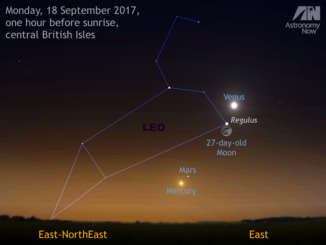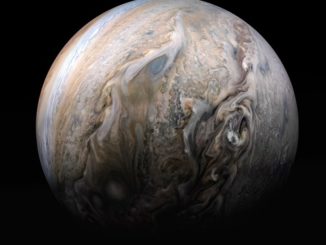
Where, then, are all the bright planets? Why, in the morning sky, of course! For those prepared to set an early alarm, a wealth of solar system activity is poised to happen in the east an hour or more before sunrise. Here you will find planets Venus, Mars and Jupiter in the constellation Leo, while Mercury in Virgo arrives on the scene around 11 October.
If you consult our Almanac and select your nearest city, sunrise and sunset data for any given date is displayed at the top of the table. What follows is a day-by-day list of pre-dawn highlights for one hour before sunrise (~6:27am for the centre of the British Isles; ~6:14am in London; ~6:32am for Edinburgh):
Thursday, 8 October
A great four-day wide-angle astrophotographic opportunity starts today when the 25-day-old waning crescent Moon lies six degrees to the upper right of dazzling Venus. The pair will fit easily into the same low-power field of 7x and 8x binoculars.
Friday, 9 October
This morning we find magnitude -4.5 Venus five degrees (or half the span of a fist held at arm’s length) above and to the right of the 26-day-old lunar crescent. Like yesterday morning, the pair will fit comfortably in the same field of view of 7x and 8x binoculars, while magnitude +1.8 Mars — a staggering 330 times fainter than Venus — also sits five degrees to the Moon’s left.
Saturday, 10 October
Today it is mighty Jupiter’s turn for a close encounter with the Moon. The slim 27-day-old lunar crescent lies five degrees below magnitude -1.7 Jupiter low in the east.
Sunday, 11 October
Look very low in the east one hour prior to sunrise to catch a glimpse of magnitude +0.3 Mercury just 2.5 degrees — half of a 10×50 binocular field — to the left of the 28-day-old Moon’s slender crescent. In practice, you may need to wait until 45 minutes before sunrise (again, the Almanac is your friend) for the pair to be high enough to be seen, even though twilight will be bright. Never sweep the horizon looking for Mercury with any optical instrument once the Sun has risen!
Inside the magazine
You can find out more about observing the morning planets in the October edition of Astronomy Now in addition to a full guide to the night sky.
Never miss an issue by subscribing to the UK’s biggest astronomy magazine. Also available for iPad/iPhone and Android devices.




